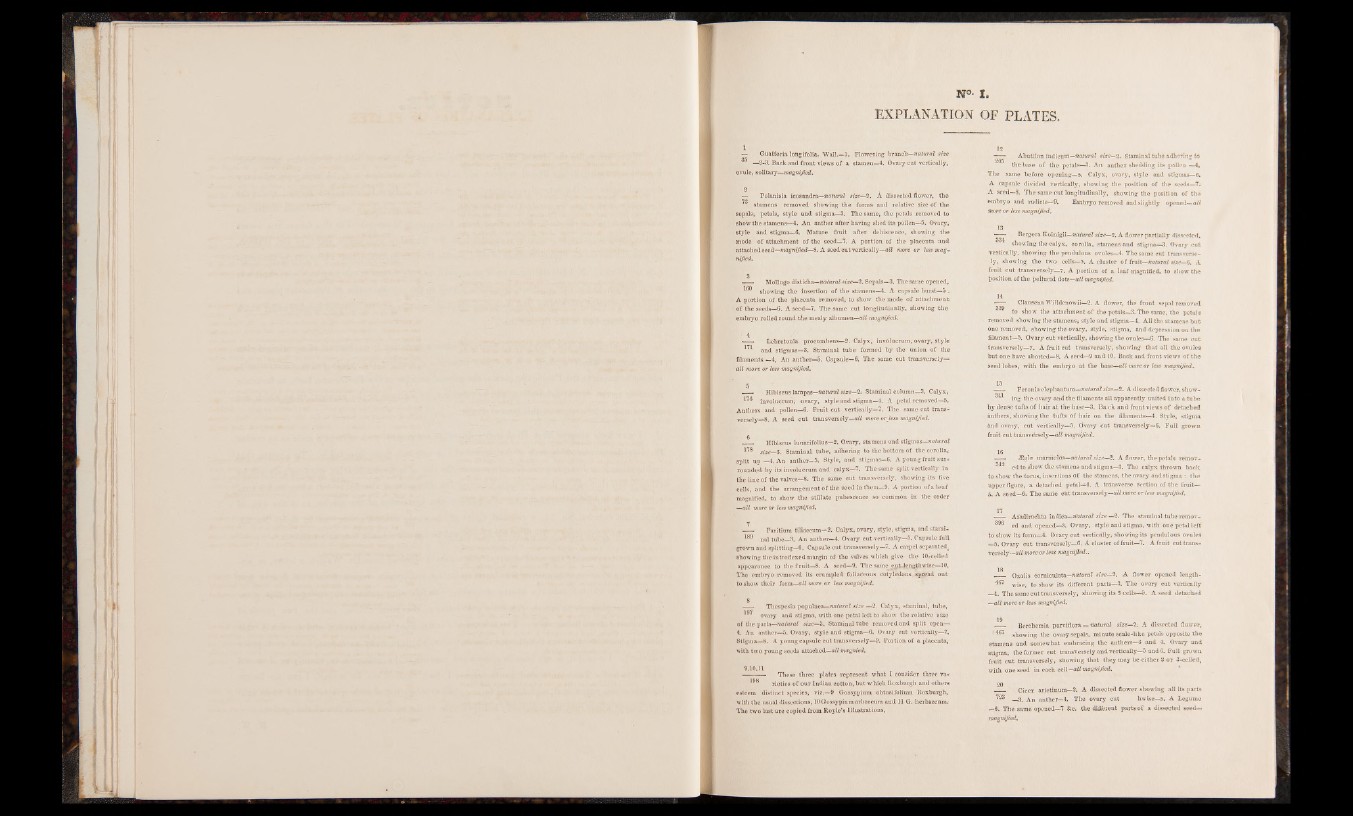
N°- î .
EXPLANATION OF PLATES.
— Guatteria longifolia. Wall.—1. Flowering branch—natural size
3<> —2-3. Back and front views of a stamen—4. Ovary cut vertically,
ovule, solitary—magnified.
— Polanisia icosandra—natural size— À dissected flower, the
3 stamens removed showing the forms and relative size o f the
sepals; petals, style and stigma—3. The same, the petals removed to
show the stamens—4. An anther after having shed its pollen—5. Ovary;
style and Stigma—6. Mature fruit after dehiscence, showing the
mode of attachment of the seed—7. A portion of the placfenta and
attached seed—magnified—8. A seed' cut vertically—all more or less mag*
nified.
3
— Mollugo disticha—natural size—2. Sepals—8. The same opened,
showing the insertion of the stamens—4. A capsule burst—5 ;
A portion of the placenta removed; to show the mode of attachment
of the seeds—6. A seed—7. The same cut longitudinally, showing the
embryo rolled round the mealy albumen—all magnified.
: 4
r ----- Lebretonia procumbens—2. Calyx, involucrum; ovary, stylé
^ and stigmas—3. Staminal tube formed by the union of thé
filaments —4, An anther—5. Capsule—6. The same cut transversely—
all more or less magnified.
---- . Hibiscus lampas—natural size— 2: Staminal column—3. Calyx,
ftW involuCrum; ovary, style and stigma—4. A petal removed—5»
Anthers and pollen—6. Fruit cut vertically—7. The same cut transversely^.
A seed cut transversely—all more or Jess magnified.
** Hibiscus lunarifolius—2. Ovary, stamens and stigmas—natural
l?8 size—3. Staminal tube, adhering to the bottom of the corolla;
split up —4. An anther—5. Style, and stigmas—6. A young fruit surrounded
by its involucrum and calyx—7. The same split vertically in
the line of the valves—8. The same cut transversely, showing its five
cells, and the arrangement of the seed in them—9. A portion of a leaf
magnified, to show the stillate pubescence so common in the order
—dll more or less magnified.
I 7
----- Faritium tilidceum—2. Calyx, ovary, style, stigma, and stami-
S p1 nal tube—3. An anther—4. Ovaty cut vertically—5. Capsule full
grown and splitting—6. Capsule cut transversely—7. A carpel separated^
showing the introflexed margin of the valves which give the lO-celled
appearance to the fruit—8. A seed—9. The same cu£4;?ngth:wise—10.
The embryo removed its crumpled foliaCeous Cotyledons spread out
to show their form—all more or less magnified.
8
----- Thespesia populnea—natural size — 2. Calyx, staminal, tube,
pjP ovary and stigma, with one petal left to show the relative size
of the parts—natural size—3, Staminal tube removed and split open—
4. An anther—5. Ovary, style and stigma—6. Ovary cut vertically—7.
Stigma—8. A young capsule cut transversely—9. Portion of a placenta,-
with two young seeds attached—all magnied.
9.10.11
----------These three plates represent what I consider three va-
1!,s rieties of our Indian cotton, but which Roxburgh and others
esteem distinct species,- viz.—9 Gossypium obtusifolium Roxburgh,
with the usual dissections, 10 Gossypium arboreum and 11 G. herbaceous.-
The two last are copied from Royle’s Illustrations,
----- Abutilon indiciim—natural size— 2. Staminal tube adhering td
the base of the petals—3. An anther shedding its pollen —4.
The same beforfe opening—5. Calyx, ovary, style and stigmas—G.
A capsule divided vertically, showing the position of the seeds—7i
A seed—8. The same cut longitudinally, showing the position of the
tembryo and radicle—9. Embryo removed and slightly opened—all
mare or less magnified.
13
■---- Bergera Koinigii—natural size—2. À flower partially dissected,
showing the calyx, corolla, stamens and stigma—3. Ovary cut
"vertically, showing the pendulous ovules—4. The same cut transversely,
showing the two cells—5. À cluster of fruit—natural size—6. A
fruit cut transvërseiy—7. À portion of a leaf magnified, to show the
position of the pellucid dots—all magnified.
14
— Claüsëna Wiildenowii—2. A flower, the front sepal removed
to show the attachment of the petals—3. The same, the petals
removed showing the stamens; style and stigma—4. All the stamens but
one removed, showing thé ovary, style, stigma, and depression on the
filament—5. Ovary cut vertically, snowing the ovules—6. The same cut
transversely—7. A fruit cut transversely, showing that all the ovules
but one have aborted—8. A seed—9 and 10. Back and front views of the
seed lobes, with the embrjro at the base—all more Or less magnified.
15 —- Feronia elephanturn—naturdl size—2. A dissected flower, show-
^ ing the ovary and the filaments all apparently united into a tube
by dense tufts of hair at the base—3. Ba ck and front views of detached
anthers, showing the tufts of hair on the filaments—4. Style, stigma
ànd ovary, cut vertically—5. Ovary Cut transversely—6. Full grown
fruit cut transversely—all magnified.
16
----- Ægle mânüelôs—natural size—2. A flower, the petals removed
to siiow the stamens and stigma—3. The calyx thrown back
to show the torus, insertions Of the stamens, the ovary and stigma : thé
Upper figure, a detached petal—4. A transverse Section of the fruit—
5. A seed—6 . The same cut transversely—all snore or less magnified.
17 .
— - Azadirachta indica—riaturdl size —2. The staminal tube remov-
ed and opened—3. Ovary, style and stigma, with önë petal left
to show its form-^4. Ovary cut vertically, showing its pendulous ovules
_ 5. Ovary cut transversely—6. A cluster of fruit—7. A fruit cut transversely—
dll more or less magnified..
Oxalis ComiciUata—naturdl size—2. A flower opened length-
wise; to show its different parts—3. The ovary cut vertically
—4. The same cut transversely; showing its 3 cells—9. A seed detached
—all more or less magnified.
___ BerCheffiia parviflora — natural size—Vs A dissected flower,
1 4®* showing the ovary sepals, minute scale-like petals opposite the
stamens and somewhat embracing the anthers—3 and 4. Ovary and
stigma, the former cut transversely and vertically—5 and 6. Full grown
fruit cut transversely, showing that they may be either 2 or 3-celled,
with one seed- in each cell—all magnified.
^ Cicer arietinum—2; A dissected flower showing all its parts
"^3 3 An anther—4. The ovary cut hwise—5. A Legume
—6. The same opened—7 &c. the different parts of a dissected seed—
magnified.